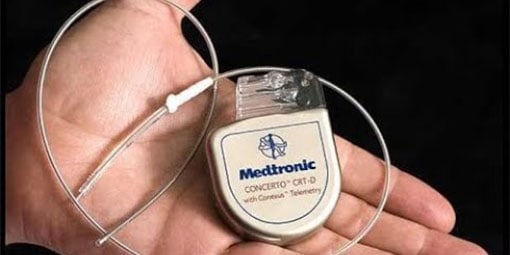除颤器植入
Under certain circumstances the beat of the heart can become abnormally fast in a very dangerous way. This usually occurs in people who already have major abnormalities of the electrical system of the heart or of the heart muscle. An Implantable Cardioverter Defibrillator (ICD) can detect such fast heartbeats and correct them by applying a series of electrical impulses to the heart or by delivering a shock to the heart.
An ICD is made up of a pulse generator, which lies under the skin just below the collarbone (usually), and 1 to 3 leads that arise from the pulse generator and go into the heart. The leads transmit the electrical impulses or shock from the pulse generator to the heart muscle.

PROCEDURE: WHAT IS INVOLVED IN ICD IMPLANTATION?
ICD insertion is a common procedure. This is performed under local anaesthetic with sedative medication to make you feel comfortable. The procedure takes approximately 1-2 hours and is performed in the cardiac catheter laboratory. This is a special room that has a patient table, X-Ray tube, ECG monitors and other equipment. The staff in the lab will all be dressed in hospital theatre clothes and during the procedure will be wearing hats and masks. Many ECG monitoring electrodes will be attached to your chest area. A nurse or doctor will insert an intravenous line usually into the back of your hand. This is needed as a reliable way to give you medications during the study without further injections.
You will also have a blood-pressure cuff attached to your arm that will automatically inflate at various times throughout the procedure. There will also be considerable attention at cleaning the skin under the collarbone where the ICD will be inserted. You will also receive antibiotics prior to the procedure. You should ensure that you inform the Doctor if you have any allergies.
The ICD is inserted just under the collarbone. The area is prepared with a special sterile solution that may feel cold. A large sterile sheet that will partly cover your face will cover you. You will be able to look out from under the sheet to the side and a nurse will be present at all times. You will be given oxygen to breathe by a small tube that is positioned under your nostrils.
At the start of the procedure, the doctor will inject local anaesthetic into the area under the collarbone where the ICD is to be inserted. This will sting momentarily but the area will then be numb. During the procedure you may feel some firm pushing in the shoulder area but this should not be painful. If you experience pain or discomfort you should tell the nurse or doctor. At the end of the procedure a fast heart rhythm will be induced and the effectiveness of the ICD will be tested. For this testing you will receive stronger sedation or occasionally a general anaesthetic. It is unlikely that you will remember much of the procedure.
After the procedure you will have some bruising and discomfort in the area of the pacemaker that may persist for several weeks. You should avoid strenuous activities with your arm for a period of 4 weeks. If the ICD is implanted without previous rhythm disturbance (primary prevention) you are legally required to refrain from driving for 2 weeks after the procedure. If the ICD is implanted after previous rhythm disturbance (secondary prevention) you are legally required to refrain from driving for 6 months and then after clearance by your Doctor.
你将被允许回家1或2天后的程序。
ICD INSERTION RISKS
Procedural risks of ICD implantation are summarised below:
- All patients will be left with a scar and an ICD (which can usually be felt) under the skin.
- 大多数患者将有一些初步的瘀伤。 如果你把阿司匹林、氯吡格雷、华法林或其他"用血液稀释剂"的淤青可能是显着的。
- 1 in 40 – The ICD leads can move after the procedure – this may require a repeat procedure to fix the problem.
- 1 in 100 – An infection may arise at the ICD site. This is a difficult problem to treat and may require the ICD to be removed.
- 1在100–肺可能崩溃。 这可能要求插入一个管reinflate肺。
- 1在200–血液凝块可能形成在锁骨下的静脉。 这是静脉,导致通过,获得心脏。
- 1 in 1000 – The leads may puncture the heart muscle, giving rise to cardiac tamponade; which may be fatal.
- 1 1000–血液凝块可能形式的双腿并进入到肺部。 这可能是致命的。
- Rare – It is possible although rare to have a life threatening allergic reaction to a medication, a stroke, heart attack or die as a result of an ICD insertion.
显然尽一切努力,以尽量减少风险的程序和你应该知道,紧急设备可处理任何并发症的发生。
It is important to understand that these are average risks. Your individual risk may be higher or lower depending on a number of factors such as your age and general health. Your cardiologist knows these risks and has considered them before recommending that you undergo an ICD implantation.
